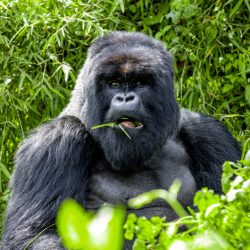‘Extreme conservation’ leads to recovery of the Virunga mountain gorillas
Blog | 10/06/11
When the numerical results of the 2010 Virunga Massif census of the critically endangered mountain gorilla, Gorilla beringei beringei, came out with a 26.3% population increase over a period of seven years (as reported by IGCP in December 2010), everyone was asking the same question- how did this happen?
A new study published this month in the journal PLoS ONE (PLoS One 6(6): 1-8) sheds light on this question by comparing the factors influencing the growth rate of the Virunga Massif population based on data collected between 1967-2008. International Gorilla Conservation Programme’s Maryke Gray, Dr. Augustin Basabose, and James Byamukama are co-authors.
The critically endangered mountain gorilla exists in only two isolated populations. One of these populations, the Virunga Massif mountain gorillas, is confined to 450 square kilometers in three contiguous national parks that straddle the borders of Rwanda, Uganda, and the Democratic Republic of Congo. The population of Virunga mountain gorillas has been increasing since a low in 1981 of 250 individuals to their current numbers of 480 individuals as censused in 2010.
The unprecedented efforts to save the Virunga mountain gorillas represent an exceptional opportunity to compare two different conservation approaches in the same population at the same time. The scientific study compared the population dynamics of unhabituated mountain gorillas and habituated mountain gorillas, those accustomed to regular contact by people for research or tourism, within the same population.
Unhabituated gorillas (currently approximately 30% of the mountain gorilla population) have benefited in recent decades from intensified ecosystem-based conservation efforts including increased park patrols throughout the Virunga massif as well as initiatives that engage local people in the conservation of the park. Even with the intensified efforts, the population of unhabituated gorillas declined between 1967 and 2008, with a population growth rate of -0.7% ± 0.059%.
In addition to ecosystem-based conservation efforts, habituated gorillas (currently approximately 70% of the mountain gorilla population) are continuously guarded and monitored throughout the daylight hours and receive veterinary care when an individual is faced with a life-threatening wound or illness. Through these extreme conservation efforts, the population growth rate was positive at 4.1% ± 0.088%.
The study analyzed the specific reasons attributed to the much higher population growth rate for habituated gorillas and identified that veterinary interventions could account for up to 40% of the difference in growth rates.
The authors state that this study suggests that ecosystem-based conservation strategies are necessary, but may not be enough to prevent some population declines, even when intensively applied in a relatively small area.
While this study clearly shows the benefits of extreme conservation efforts to the overall population numbers of the mountain gorillas, the authors stress that habituation of the entire population is not the answer to future conservation of this critically endangered species.
“Although this study shows that habituation can mean direct hands-on care with the benefits it provides, we must also continue efforts to conserve unhabituated groups,” states Maryke Gray, IGCP Technical Advisor and an author of the study. “Unhabituated groups may be key to the overall health and vitality of the population, as they are not exposed to the risks associated with habituation including vulnerability to poachers due to lack of fear of humans as well as increased risk of disease transmission.”
The full report from the 2010 Virunga Massif census, forthcoming, will shed more light on the population growth rates of habituated and unhabituated mountain gorillas between the census of 2003 and the one conducted in 2010.
The International Gorilla Conservation Programme, a coalition of the African Wildlife Foundation, Fauna & Flora International, and the World Wide Fund for Nature, has and continues to support the collection and analysis of data from ranger-based monitoring (RBM) as well as the periodic census of the two transboundary mountain gorilla populations in the Democratic Republic of Congo, Rwanda, and Uganda.
###
Founded in 1991, the mission of the International Gorilla Conservation Programme is to conserve the critically endangered mountain gorillas and their habitat through partnering with key stakeholders while significantly contributing to sustainable livelihood development. More at www.igcp.org.
There are an estimated 780 mountain gorillas existing in the world, found only in the Democratic Republic of Congo, Rwanda, and Uganda.
The full report on the 2010 Virunga Massif census of mountain gorillas is forthcoming.
Citation: Robbins MM, Gray M, Fawcett KA, Nutter FB, Uwingeli P, et al. (2011) Extreme Conservation Leads to Recovery of the Virunga Mountain Gorillas. PLoS ONE 6(6): e19788. doi:10.1371/journal.pone.0019788


